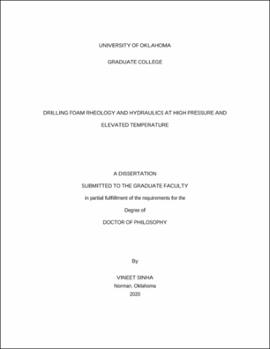| dc.description.abstract | Foam has been successfully used as the motive fluid for different operations such as well stimulation, underbalanced drilling, enhanced oil recovery (EOR), cleanout, and acidizing operations in the oil and gas industry. Due to its low liquid content, it provides a distinct advantage with regards to less material requirements. However, due to its structure-driven viscosity, high compressibility, and complex flow behavior, accurate predictions of rheology and hydraulic parameters are essential for the success of field operations. This investigation focuses on rheological and hydraulic characteristics of foams, incorporating the effect of temperature on their flow behavior.
In this investigation, polyanionic cellulose (PAC) polymer (0.25% by wt.) based foam was generated using nitrogen as the gas phase and its rheology was determined using a recirculating flow loop that has three pipe viscometers (3.05, 6.22, and 12.7 mm OD) and fully-eccentric annular section (3.05 mm OD × 12.57 mm ID, and 9.53 mm OD × 12.57 mm ID). Experiments were conducted within the temperature range of 24 to 149ºC and at various foam qualities (0%, 45%, 55%, 65%, and 75%).
The foams displayed power-law fluid behavior in the shear rate range tested (100 to 5000 s-1), which is often experienced in the wellbore. Like its base liquid, polymer foam exhibited thermal thinning and a significant rheology change with temperature. Only high-quality foam (75%) at ambient temperature (24ºC) showed yielding behavior, which was measured in a pipe viscometer under static condition. The disappearance of yield stress at elevated temperature could be attributed to the thermal thinning of the liquid phase that weakens the strength of the bubble structure. Experimental data is used to develop new correlations to predict power-law fluid parameters as a function of temperature, base fluid properties, and foam quality. Moreover, the measurements are compared with the predictions of existing models, and discrepancies are observed, which could be attributed to the variation in foam generation technique, the nature and concentration of polymer, and the concentration of surfactant used in the experiments in which data was obtained to develop the models.
Furthermore, annular pressure loss measurements obtained from fully eccentric annulus at low temperatures (24 and 79ºC) show predominantly good agreement with predictions of a hydraulic model that uses the new correlations. Discrepancies increased with temperature as the foam becomes unstable due to the thermal thinning of the liquid film and subsequent weakening of bubble structure and reduced stability of foam.
A mathematical model has been developed by applying mechanical energy balance on small discretized control volume in the wellbore. The model combines the effect of hydrostatic, frictional and acceleration pressure loss components on the calculation of bottom hole pressure, and predicts foam quality, density, velocity, and pressure at different measured depths. A parametric study was performed to understand the effect of different variables on the foam drilling hydraulics. | en_US |

